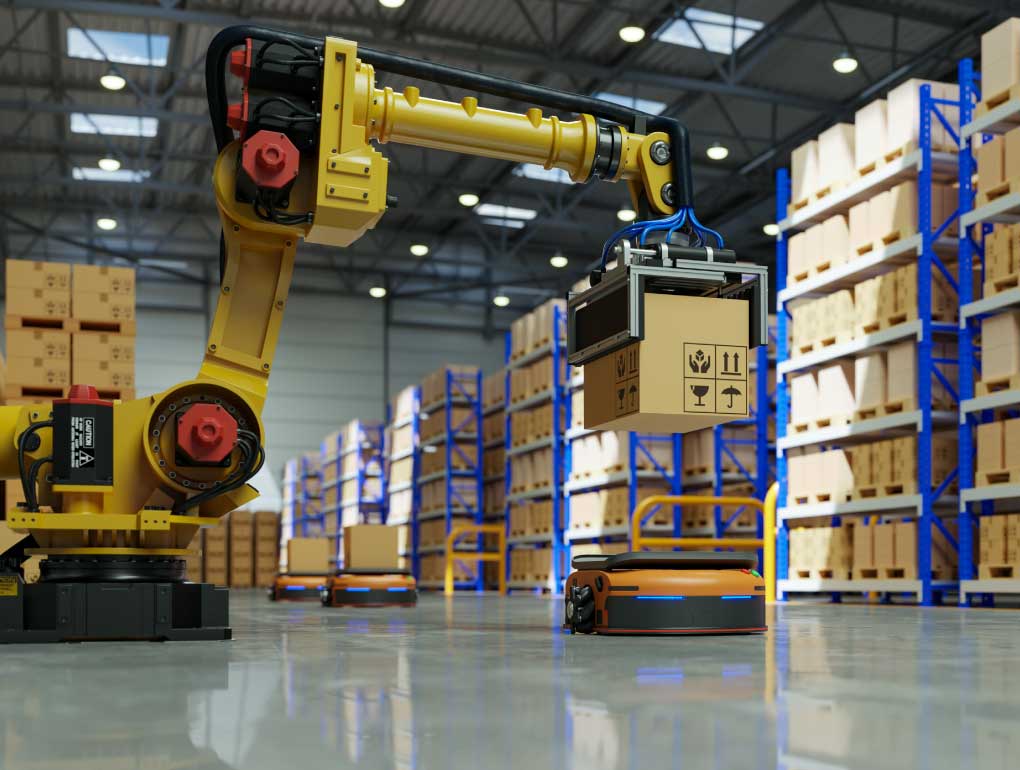Imagine ordering a product online and receiving it the same day. This is no longer a luxury but an expectation for 97% of consumers. Behind this seamless experience lies a revolution in logistics, driven by cutting-edge technology.
In Australia, businesses are embracing AI, IoT, and robotics to streamline their operations. These systems are replacing manual processes, boosting efficiency, and reshaping the entire supply chain. For example, Amazon’s use of robotics in its facilities has set a new standard for speed and accuracy.
This shift isn’t just about keeping up with competitors; it’s about staying ahead. Companies that adopt these innovations gain a significant edge in the fast-paced world of e-commerce. As technology continues to evolve, the future of logistics looks smarter, faster, and more connected than ever.
Introduction to Warehouse Management
In today’s fast-paced world, efficient logistics is the backbone of successful businesses. At the heart of this efficiency lies warehouse management, a critical component of the supply chain. It involves the strategic coordination of goods storage, movement, and organization to ensure smooth operations.
What is Warehouse Management?
Warehouse management refers to the processes and systems used to oversee the storage and movement of goods. It ensures that products are stored correctly, tracked accurately, and delivered on time. With the help of Warehouse Management Systems (WMS), businesses can automate these tasks, reducing errors and improving efficiency.
The Role of Technology in Modern Warehousing
Technology has revolutionized how warehouses operate. Traditional methods, which relied heavily on manual labor, are being replaced by advanced systems. WMS provides real-time inventory visibility, enabling businesses to track stock levels and streamline order fulfillment.
Modern fulfillment centers leverage AI and IoT to optimize operations. These technologies reduce inventory shrinkage, which costs businesses billions annually. The integration of AI and IoT marks the evolution towards WM 4.0, where warehouses are smarter, faster, and more connected than ever.
The Evolution of Warehouse Management
From handwritten ledgers to AI-driven systems, logistics has come a long way. The journey from manual processes to advanced automation reflects decades of innovation. Today, businesses rely on sophisticated systems to manage their operations efficiently.
From Manual Processes to Automation
In the 19th century, inventory tracking relied on manual ledgers and physical counts. These methods were time-consuming and prone to errors. The 1970s marked a turning point with the adoption of barcodes, revolutionizing inventory tracking.
As technology advanced, standalone systems emerged, offering basic tracking capabilities. However, the integration of ERP systems brought a new level of efficiency. These integrated solutions streamlined processes, reducing manual intervention and improving accuracy.
The Rise of Warehouse Management Systems (WMS)
The growth of e-commerce has driven the need for real-time tracking systems. Warehouse management systems (WMS) have become essential for businesses to meet customer demands. These systems provide real-time visibility, ensuring products are stored and moved efficiently.
By 2025, 26% of retail orders are expected to be online. This shift has forced businesses to adopt advanced WMS solutions. These systems not only improve efficiency but also reduce costs and enhance customer satisfaction.
Key Components of a Warehouse Management System
Efficient operations rely on a well-structured management system. These systems integrate advanced tools to streamline processes, reduce errors, and enhance productivity. Below are the core components that make these systems indispensable in modern logistics.
Inventory Tracking and Control
Real-time visibility is crucial for effective inventory management. RFID and IoT sensors enable businesses to monitor stock levels accurately. This reduces errors and prevents issues like stockouts or overstocking.
AI-powered demand forecasting further enhances this process. It predicts future needs, ensuring businesses maintain optimal stock levels. This minimizes waste and maximizes efficiency.
Order Fulfillment and Shipping
Order fulfillment is a critical aspect of any management system. Wave picking strategies reduce travel time by up to 40% in large facilities. This speeds up the process and improves accuracy.
Automated carrier rate comparison tools cut shipping costs by 15-25%. These tools analyze rates from multiple carriers, ensuring businesses choose the most cost-effective option.
Labor Management and Productivity
Labor management modules optimize staffing costs through shift optimization. These tools ensure the right number of workers are scheduled at the right times. This boosts productivity and reduces unnecessary expenses.
By integrating these components, businesses can achieve seamless operations. A robust management system not only improves efficiency but also enhances customer satisfaction.
The Benefits of Advanced Warehouse Management
The integration of advanced systems in logistics has unlocked unprecedented benefits for businesses. These innovations streamline operations, reduce expenses, and enhance customer experiences. Below, we explore the key advantages of adopting these cutting-edge solutions.
Improved Efficiency and Accuracy
Advanced systems significantly boost operational efficiency. For instance, RFID technology ensures 99.9% inventory accuracy, minimizing errors and delays. Zone picking strategies further enhance this by speeding up order processing by 30%. These improvements allow businesses to meet customer demands faster and more reliably.
Cost Reduction and Space Optimization
Effective systems can reduce operational costs by up to 25%. Vertical storage solutions, for example, increase storage capacity by 200%, optimizing space usage. This not only cuts expenses but also allows businesses to scale operations without expanding physical footprints.
Enhanced Customer Satisfaction
Faster fulfillment directly impacts customer retention rates, increasing them by 23%. Automated quality control processes, like those used by an Australian retailer, have reduced returns by 18%. These advancements ensure customers receive their orders accurately and on time, fostering loyalty and trust.
Modern Technologies in Warehouse Management
The rapid advancement of technology is reshaping how businesses handle logistics. From AI to robotics, these innovations are driving efficiency and accuracy in ways never seen before. Companies worldwide are adopting these tools to stay competitive and meet growing customer demands.
AI and Machine Learning
AI-powered predictive analytics is transforming inventory management. By analyzing historical data, these systems reduce stockouts by 35%. This ensures businesses maintain optimal stock levels, minimizing waste and maximizing efficiency.
Machine learning also enhances demand forecasting. It predicts future needs with precision, allowing companies to plan better. This reduces overstocking and ensures products are available when customers need them.
IoT and Real-Time Tracking
IoT-enabled pallet tracking is cutting loss prevention costs by 40%. Sensors provide real-time updates on inventory location and condition. This reduces errors and ensures goods are tracked accurately throughout the supply chain.
Real-time tracking also improves transparency. Businesses can monitor shipments and address issues immediately. This leads to faster deliveries and higher customer satisfaction.
Robotics and Automation
Collaborative robots, or cobots, are increasing picking speed by 300%. These robots work alongside humans, enhancing productivity without replacing jobs. Amazon, for example, uses over 200,000 mobile robots in its facilities to streamline material handling.
Computer vision systems are achieving 99.95% packing accuracy. These tools ensure orders are processed correctly, reducing returns and improving customer trust. In Australia, Linfox has implemented automated cold chain management, setting a benchmark for efficiency.
Automation is not just about speed; it’s about precision. These systems minimize errors and ensure operations run smoothly, even during peak times.
Warehouse Management Strategies for 2025
As businesses prepare for 2025, innovative strategies are reshaping how goods are stored and delivered. These approaches focus on leveraging technology to meet growing consumer demands while improving operational efficiency. Below, we explore three key strategies that are set to dominate the logistics landscape in the coming years.
AI-Driven Demand Forecasting
AI-powered systems are transforming how businesses predict demand. By analyzing historical data and regional variations, these systems reduce excess inventory by 20-50%. Machine learning models can forecast future needs with precision, ensuring optimal stock levels.
This approach minimizes waste and maximizes efficiency. For example, an Australian retailer using AI forecasting has seen a 30% reduction in overstocking. Such systems are essential for businesses aiming to stay competitive in a fast-paced market.
Multi-Warehouse Synchronization
Cloud-based systems are enabling real-time inventory synchronization across multiple locations. This ensures that businesses can track stock levels accurately, regardless of where goods are stored. For instance, a global e-commerce company uses this technology to manage inventory across continents seamlessly.
These systems improve supply chain transparency and reduce delays. By integrating real-time data, businesses can respond quickly to changes in demand, ensuring timely deliveries and satisfied customers.
Sustainable Warehousing Practices
Sustainability is becoming a priority for businesses worldwide. Solar-powered facilities, like those in NSW, are cutting energy costs by 60%. These practices not only reduce expenses but also align with environmental goals.
Blockchain technology is also being integrated for ethical supply chain verification. This ensures that goods are sourced responsibly, building trust with consumers. Additionally, route optimization tools save $4.07 per order, further enhancing efficiency.
By adopting these strategies, businesses can achieve a balance between operational efficiency and sustainability. These practices are essential for staying competitive in 2025 and beyond.
The Role of Robotics in Modern Warehousing
Robotics is redefining how goods are handled in modern logistics. From picking and packing to storage and retrieval, these advanced systems are driving efficiency and accuracy. In Australia, businesses are increasingly adopting robotics to stay competitive in a fast-paced market.
Automated Picking and Packing
Automated picking systems are revolutionizing order fulfillment. AI-powered sorting arms, for example, can process up to 6,000 items per hour. This level of speed and precision ensures faster deliveries and reduces errors.
Robotic systems like Blue Yonder’s can handle 1,500 units per hour. These tools not only improve efficiency but also cut costs. Maintenance expenses for robotics are as low as $0.03 per unit, compared to $0.12 for manual handling.
Robotic Storage and Retrieval Systems
Robotic storage systems are optimizing space and reducing storage time by 75%. Autonomous Mobile Robots (AMRs) and Automated Guided Vehicles (AGVs) are commonly used in Australian logistics environments. AMRs offer greater flexibility, while AGVs are ideal for structured layouts.
Safety protocols are critical in human-robot collaboration zones. These measures ensure seamless interaction between workers and robotic systems. By integrating these technologies, businesses can achieve higher productivity and operational efficiency.
Warehouse Management in Australia
Australia’s logistics sector is undergoing a transformative shift, driven by technology and unique local challenges. Businesses are adapting to meet the demands of a rapidly evolving market. From labor costs to vast distances, the country’s logistics landscape presents both opportunities and hurdles.
Local Trends and Challenges
Australian logistics face higher labor costs, 34% above Asian counterparts. This has pushed businesses to seek cost-effective solutions. The vast distances between cities also increase last-mile delivery expenses, making efficiency a top priority.
Australian Consumer Law impacts returns management, requiring businesses to streamline processes. Companies are adopting advanced systems to handle returns efficiently and comply with regulations. This ensures customer satisfaction while minimizing costs.
Adoption of Advanced Technologies
In Australia, 68% of logistics facilities now use cloud-based WMS. These systems provide real-time visibility and streamline operations. For example, Kogan’s automated fulfillment center in Sydney has set a benchmark for efficiency.
Government incentives in regional Western Australia encourage automation adoption. These programs aim to boost productivity and reduce reliance on manual labor. By leveraging technology, businesses can overcome challenges and stay competitive.
From AI to IoT, Australian logistics is embracing innovation. These advancements are not just improving operations but also shaping the future of the industry. The focus is on creating smarter, faster, and more sustainable systems.
10-Step Advanced Warehouse Management Process
A well-structured process is key to reducing errors and improving efficiency in logistics. This 10-step approach ensures seamless operations from receiving goods to shipping orders. By integrating advanced tools, businesses can achieve 90% fewer errors through barcode verification and other technologies.
Receiving and Quality Control
The first step involves verifying incoming goods. AI vision systems are now used for 100% inbound quality checks. These systems scan products for defects or discrepancies, ensuring only high-quality items enter the system.
Putaway and Location Assignment
Dynamic slotting algorithms optimize storage locations based on product demand and turnover rates. This reduces travel time and ensures frequently picked items are easily accessible. Such strategies enhance overall efficiency in operations.
Order Picking and Packing
Batch and zone picking strategies are compared to determine the best approach for high-volume facilities. Automated packaging systems adapt box -sizes in real-time, minimizing waste and speeding up the packing process. These innovations ensure orders are processed quickly and accurately.
Shipping and Reverse Logistics
Automated systems streamline shipping by selecting the most cost-effective carriers. Reverse logistics is also optimized, with automated returns processing restocking 22% faster. This ensures products are back in inventory quickly, ready for the following order.
By following this 10-step process, businesses can enhance their operations, reduce errors, and meet customer demands efficiently. The integration of advanced tools ensures a seamless and reliable logistics system.
Key Benefits of Implementing a WMS
Implementing a WMS can transform how businesses handle their logistics operations. From faster shipping to improved inventory accuracy, these systems offer a range of advantages. Companies that adopt a WMS can streamline processes, reduce costs, and boost productivity.
Streamlined Logistics and Faster Shipping
One of the standout benefits of a WMS is its ability to speed up order processing. Integrated systems can reduce fulfillment times by up to 30%. This ensures that customers receive their orders faster, enhancing satisfaction and loyalty.
Real-time tracking features also improve shipping accuracy. Businesses can monitor shipments and address delays proactively. This leads to smoother operations and fewer customer complaints.
Improved Inventory Accuracy
Accuracy is critical in logistics, and a WMS delivers on this front. Users report 99.9% inventory accuracy, compared to just 95% with manual methods. This reduces errors, minimizes stockouts, and ensures products are always available when needed.
Advanced algorithms optimize storage space, increasing capacity by up to 40%. This not only cuts costs but also allows businesses to scale operations without expanding physical footprints.
Lower Labor Costs and Increased Productivity
Automation is a key feature of modern WMS solutions. By automating repetitive tasks, businesses can reduce labor costs by 25%. This frees up employees to focus on higher-value activities, boosting overall productivity.
For Australian businesses, automated GST reporting ensures compliance with local regulations. This reduces administrative burdens and minimizes the risk of errors. With a typical ROI timeline of 14 months, investing in a WMS is a smart move for any company looking to stay competitive.
Types of Warehouse Management Systems
Choosing the right system for logistics operations can make or break a business. With various options available, understanding the differences between standalone, integrated, and cloud-based solutions is crucial. Each type offers unique benefits tailored to specific business needs.
Standalone WMS
Standalone systems are designed specifically for managing logistics operations. They often require a significant upfront investment, with costs averaging around $50,000. These systems are ideal for businesses that need dedicated functionality without the complexity of broader enterprise solutions.
However, standalone systems may lack the seamless integration found in other options. This can lead to inefficiencies when coordinating with other business processes. Despite this, they remain a popular choice for companies focused solely on optimizing their logistics.
Integrated ERP and SCM-based WMS
Integrated systems combine logistics management with broader enterprise resource planning (ERP) and supply chain management (SCM) functions. For example, SAP EWM integrates with GST compliance modules, making it a strong choice for Australian businesses.
These systems offer a holistic approach, streamlining operations across multiple departments. While they require a higher initial investment, the long-term benefits of improved efficiency and reduced errors often justify the cost.
Cloud-Based WMS
Cloud-based solutions have seen a 127% adoption growth in Australia since 2020. These systems are cost-effective, with monthly fees starting as low as $199. They also offer flexibility, allowing businesses to scale operations without significant upfront costs.
Security is a key consideration for cloud-based systems. Providers like AWS and Azure ensure data sovereignty, which is critical for Australian businesses. Additionally, cloud-based WMS integrates seamlessly with platforms like Shopify, enhancing e-commerce operations.
Hybrid systems, blending on-premise and cloud functionality, are also gaining traction. These solutions offer the best of both worlds, combining the security of on-premise systems with the scalability of cloud-based platforms.
Features of a Good Warehouse Management System
Modern logistics thrives on systems that adapt to real-time demands. A robust management solution ensures seamless operations, from inventory tracking to order fulfillment. For businesses in Australia, these features are essential to stay competitive in a fast-paced market.
Real-Time Inventory Tracking
Real-time tracking is a cornerstone of efficient operations. IoT sensors, for example, monitor perishable goods, ensuring freshness and reducing waste. RFID technology provides instant updates on stock levels, minimizing errors and delays.
These tools are particularly valuable for Australian businesses managing large inventories. With real-time data, companies can respond quickly to changes in demand, ensuring products are always available when needed.
Advanced Reporting and Analytics
Custom reports tailored to Australian operational metrics offer valuable insights. Predictive analytics help businesses forecast demand, reducing overstocking and stockouts. This ensures optimal inventory levels and maximizes efficiency.
Advanced analytics also identifies trends, enabling businesses to make data-driven decisions. For example, a retailer might use these insights to optimize storage locations, reducing travel time and improving productivity.
Mobile-Friendly Design
Mobile accessibility is crucial for modern systems. AR-powered interfaces guide workers through picking processes, enhancing accuracy and speed. These tools are handy in extensive facilities, where efficiency is key.
API connections to shipping systems like Australia Post and StarTrack streamline logistics. Mobile-friendly software ensures workers can access critical information on the go, improving overall productivity.
Cybersecurity features are also essential, ensuring compliance with Australia’s Privacy Act. Secure mobile access protects sensitive data, building trust with customers and partners.
Best Warehouse Management Software in 2025
In 2025, logistics software will redefine how businesses handle inventory and shipping. Companies are adopting advanced systems to streamline operations, reduce costs, and meet customer demands. Below, we explore three top software solutions: Easyship, ShipHero, and Blue Yonder.
Easyship
Easyship offers a free tier, making it accessible for small businesses. Its cross-border compliance features simplify AU-Asia trade, ensuring smooth international shipping. The software integrates with major carriers, providing real-time tracking and cost-effective solutions.
ShipHero
ShipHero handles over 10 million orders annually with 99.97% accuracy. Its AU-specific carrier integrations streamline shipping for local businesses. The platform also offers robust inventory tracking, ensuring products are always in stock and ready to ship.
Blue Yonder
Blue Yonder stands out with its AI-powered replenishment algorithms. These systems optimize inventory levels, reducing overstocking and stockouts. While pricing starts at $4,000 per month, the software’s advanced features justify the investment for larger operations.
Implementation timelines for these systems average 6-8 weeks, ensuring a smooth transition. Whether you’re a small business or a large enterprise, these software solutions offer the tools needed to stay competitive in 2025.
Warehouse Management and E-commerce Integration
The seamless connection between ecommerce and logistics is transforming how businesses operate. As online shopping grows, companies are integrating advanced systems to streamline processes and meet customer expectations. This integration ensures faster order fulfillment, efficient returns management, and an enhanced shopping experience.
Automated Order Processing
Real-time stock synchronization with platforms like Shopify and WooCommerce ensures accurate inventory updates. This prevents overselling and reduces delays in order processing. Automated systems handle order tracking, reducing manual errors and speeding up fulfillment.
For example, integrated WMS solutions can process orders 30% faster. This efficiency is crucial for businesses aiming to meet the high demands of ecommerce customers.
Online Returns Management
Returns are a significant aspect of ecommerce, and managing them efficiently is key. Automated RMA processing with prepaid return labels simplifies the process for customers. AI chatbots handle 80% of return inquiries, providing instant support and reducing workload for staff.
Integrated systems also reduce returns processing time by 65%. This ensures products are restocked quickly, minimizing losses and improving inventory turnover.
Enhancing Customer Experience
Personalized packaging is becoming a trend, increasing Net Promoter Scores (NPS) by 15 points. Customers appreciate the attention to detail, which fosters loyalty and repeat purchases.
In Australia, Temple & Webster’s 2-hour metro delivery service sets a benchmark for customer satisfaction. By leveraging advanced logistics, they ensure fast and reliable deliveries, meeting the expectations of modern shoppers.
These innovations highlight the importance of integrating ecommerce and logistics. Businesses that adopt these strategies can stay competitive and deliver exceptional customer experiences.
Future Trends in Warehouse Management
The logistics industry is on the brink of a technological revolution, shaping the future of how goods are stored and delivered. From predictive maintenance to last-mile optimization, businesses are adopting cutting-edge solutions to stay ahead. These trends are not just about efficiency; they’re about redefining the entire supply chain.
Predictive Maintenance and Smart Access Control
Predictive maintenance is transforming how facilities operate. By using sensors and AI, businesses can identify equipment issues before they cause downtime. This reduces costs and ensures smooth operations. For example, digital twin technology allows companies to simulate scenarios and optimize workflows.
Smart access control is another game-changer. Biometric systems, like fingerprint or facial recognition, are reducing security breaches by 90%. These systems ensure only authorized personnel can access sensitive areas, enhancing safety and compliance.
Last-Mile Delivery Optimization
Last-mile delivery remains a critical challenge, especially in urban areas. To address this, companies are testing drone deliveries in Sydney and Melbourne. These trials aim to reduce delivery times and costs while minimizing traffic congestion.
5G-enabled automated guided vehicles (AGVs) are also making waves. With response times as low as 10ms, these vehicles can navigate complex environments efficiently. This technology is beneficial in large facilities where speed and precision are essential.
The Shift Towards WM 4.0
WM 4.0 represents the next evolution in logistics. By integrating AI, IoT, and robotics, businesses can achieve unprecedented levels of efficiency. Adoption of WM 4.0 is expected to grow by 300% by 2027, driven by its ability to streamline operations and reduce costs.
Hydrogen fuel cells are another innovation gaining traction in Australia. These cells power logistics fleets, offering a sustainable alternative to traditional fuels. This shift aligns with global efforts to reduce carbon emissions and build greener supply chains.
As these trends gain momentum, businesses must adapt to stay competitive. The future of logistics is not just about technology, it’s about creating smarter, faster, and more sustainable systems.
Embracing the Future of Warehouse Management
The future of logistics is being shaped by cutting-edge technology, offering businesses new ways to streamline operations and stay competitive. With 73% of Australian logistics firms planning AI investments by 2026, adopting advanced solutions is no longer optional; it’s essential.
Automation delivers significant ROI, especially in high-cost labor markets like Australia. By reducing manual tasks, businesses can improve efficiency and focus on strategic growth. Workforce reskilling is equally essential, ensuring employees can adapt to new technologies and thrive in evolving roles.
For SMEs, a step-by-step implementation roadmap is crucial. Start with assessing current processes, then gradually integrate tools like AI and IoT. This approach minimizes disruption while maximizing benefits.
Now is the time to embrace the future of warehouse management. Assess your technology needs today to stay ahead in tomorrow’s logistics landscape.









